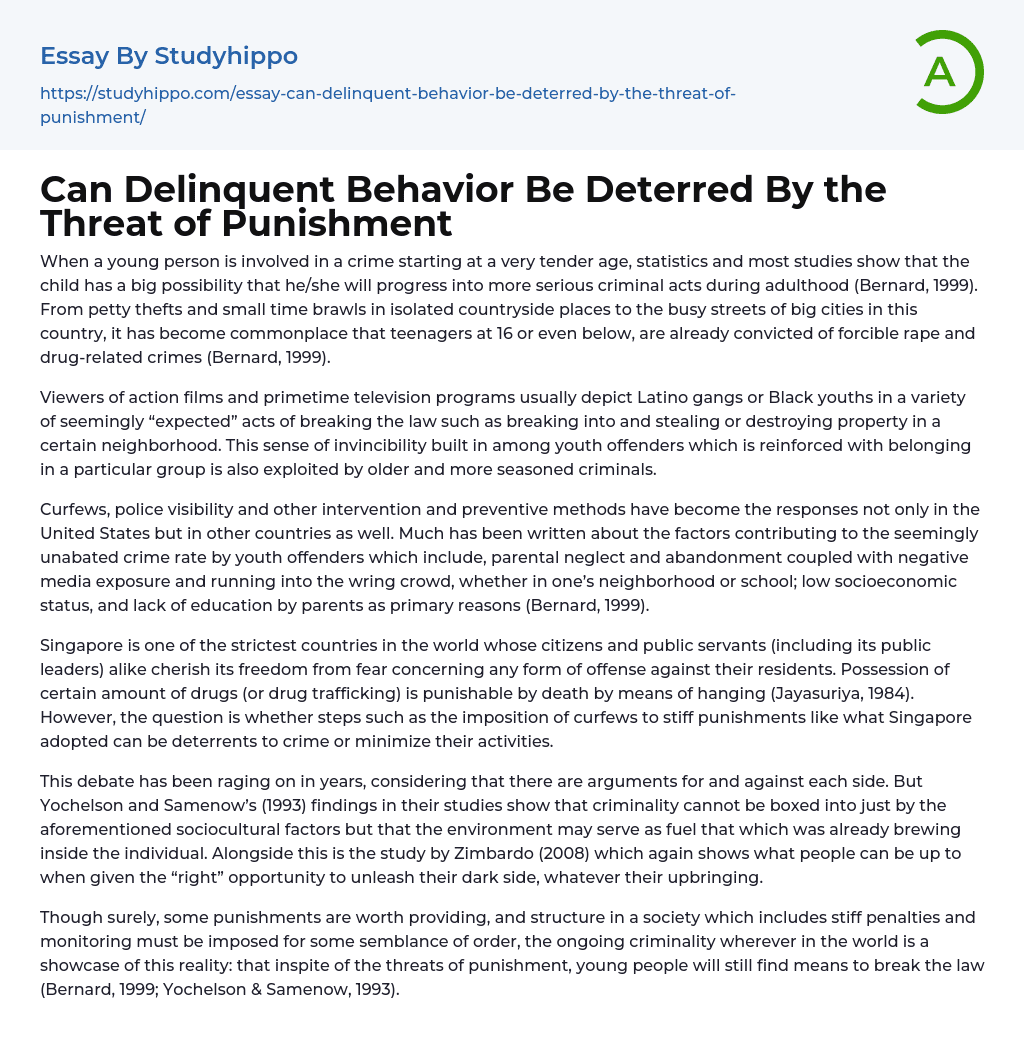

Can Delinquent Behavior Be Deterred By the Threat of Punishment Essay Example
When a young person is involved in a crime starting at a very tender age, statistics and most studies show that the child has a big possibility that he/she will progress into more serious criminal acts during adulthood (Bernard, 1999). From petty thefts and small time brawls in isolated countryside places to the busy streets of big cities in this country, it has become commonplace that teenagers at 16 or even below, are already convicted of forcible rape and drug-related crimes (Bernard, 1999).
Viewers of action films and primetime television programs usually depict Latino gangs or Black youths in a variety of seemingly “expected” acts of breaking the law such as breaking into and stealing or destroying property in a certain neighborhood. This sense of invincibility built in among youth offenders which is reinforced with belonging in a particular gr
...oup is also exploited by older and more seasoned criminals.
Curfews, police visibility and other intervention and preventive methods have become the responses not only in the United States but in other countries as well. Much has been written about the factors contributing to the seemingly unabated crime rate by youth offenders which include, parental neglect and abandonment coupled with negative media exposure and running into the wring crowd, whether in one’s neighborhood or school; low socioeconomic status, and lack of education by parents as primary reasons (Bernard, 1999).
Singapore is one of the strictest countries in the world whose citizens and public servants (including its public leaders) alike cherish its freedom from fear concerning any form of offense against their residents. Possession of certain amount of drugs (or drug trafficking
is punishable by death by means of hanging (Jayasuriya, 1984). However, the question is whether steps such as the imposition of curfews to stiff punishments like what Singapore adopted can be deterrents to crime or minimize their activities.
This debate has been raging on in years, considering that there are arguments for and against each side. But Yochelson and Samenow’s (1993) findings in their studies show that criminality cannot be boxed into just by the aforementioned sociocultural factors but that the environment may serve as fuel that which was already brewing inside the individual. Alongside this is the study by Zimbardo (2008) which again shows what people can be up to when given the “right” opportunity to unleash their dark side, whatever their upbringing.
Though surely, some punishments are worth providing, and structure in a society which includes stiff penalties and monitoring must be imposed for some semblance of order, the ongoing criminality wherever in the world is a showcase of this reality: that inspite of the threats of punishment, young people will still find means to break the law (Bernard, 1999; Yochelson & Samenow, 1993).
- Perseverance essays
- Expressive essays
- Character Traits essays
- Apology essays
- Compassion essays
- Mass Incarceration essays
- Adult essays
- Aggression essays
- Altruism essays
- Archetype essays
- Behavior essays
- Certainty essays
- Conformity essays
- Deception essays
- Human Behavior essays
- Human Sexuality essays
- Maturity essays
- Morality essays
- Obedience essays
- Procrastination essays
- Reinforcement essays
- Role Model essays
- Animal Cruelty essays
- Charles Manson essays
- Crime Prevention essays
- Crime scene essays
- Criminal Justice essays
- Criminology essays
- Cyber Crime essays
- Damages essays
- Detention essays
- Distracted Driving essays
- Drug Trafficking essays
- Drunk Driving essays
- Forensic Science essays
- Gang essays
- Hate Crime essays
- Homicide essays
- Identity Theft essays
- Juvenile Crime essays
- Juvenile Delinquency essays
- Juvenile Justice System essays
- Law Enforcement essays
- Murder essays
- Organized Crime essays
- Penology essays
- Piracy essays
- Prison essays
- Property Crime essays
- Prostitution essays



